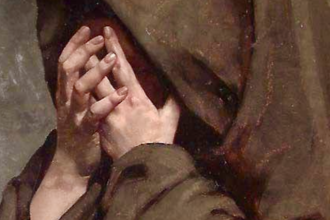Claire Wilkerson
Get thee to a nunnery is a short but perplexing phrase. The Nunnery Scene (3.1) in Shakespeare’s Hamlet encompasses the spirit of the play as a whole. The themes and struggles that are revealed in Hamlet’s monitored conversation with Ophelia lay the foundation for the climax of Hamlet’s struggles. Although Hamlet’s attitude toward Ophelia in the Nunnery Scene is cruel, Hamlet’s cruelty is better understood as despair instead of hatred because of how deeply Hamlet cares for Ophelia and how seriously he takes his mission of revenge.
It is important to consider Hamlet’s motivations leading up to his interaction with Ophelia in the Nunnery Scene. In Act 1 Scene 5 Hamlet encounters the ghost of his father who reveals that king Claudius, Hamlet’s uncle, killed his father. Claudius killed his own brother to take his crown and to marry his wife, Hamlet’s mother. The ghost of king Hamlet commands his son to seek revenge on his behalf because his soul is caught and cannot pass on to the next world until the evil done against him is corrected (1.5.10-25). Later on, approaching the Nunnery Scene, in Act 3, Hamlet gives his famous “to be or not to be” soliloquy which sheds light on Hamlets moral struggle in this scene. In the soliloquy Hamlet famously says, “To be or not to be that is the question” (3.1.55). Hamlet is asking whether it is better to live or to die. He is struggling between the dual realities of life’s suffering and death’s uncertainty. He concludes his speech as Ophelia enters the room saying; “Thus conscience does make cowards” (1.3.82). Hamlet’s conscience paralyzes him from actually making decisions. Hamlet’s anger––fueled by his uncle’s murder of his father, his mother’s marriage to his uncle, and his own inability to act––contributes to his attitude in the Nunnery Scene. » Read More
https://theimaginativeconservative.org/2025/02/get-thee-nunnery-claire-wilkerson.html
Have an existing account?
Sign In
© 2024 Paperless Times





